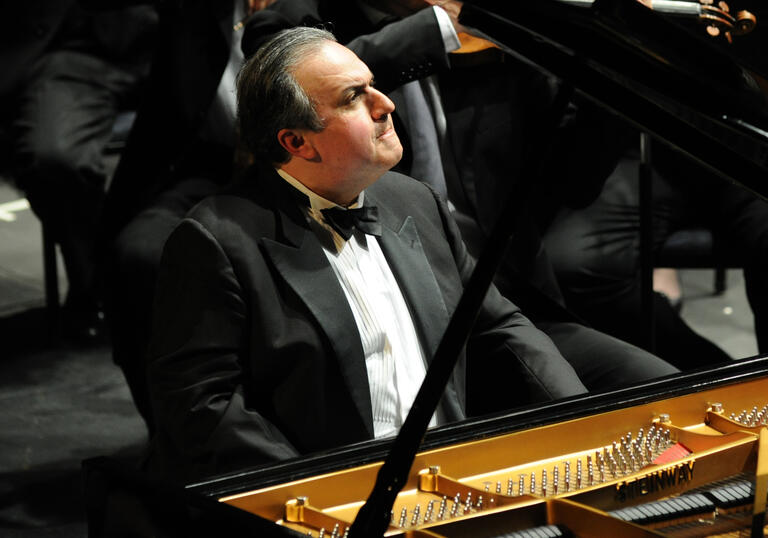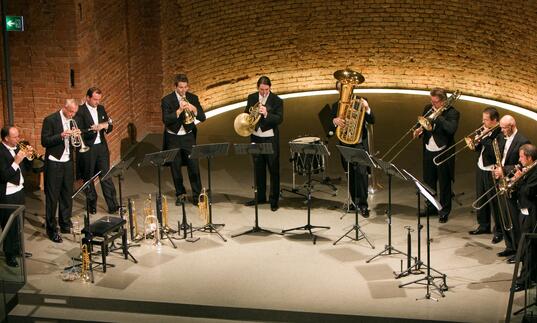
Programme and performers
Richard Wagner Prelude to Tristan und Isolde
Robert Schumann Piano Concerto in A minor
1. Allegro affettuoso
2. Intermezzo: Andantino grazioso
3. Allegro vivace
Gustav Mahler Symphony No 4
1. Bedächtig. Nicht eilen [Deliberate. Don’t
hurry] – Recht gemächlich [Very leisurely]
2. In gemächlicher Bewegung. Ohne Hast
[At a leisurely pace. Without haste]
3. Ruhevoll [Restful]
4. Sehr behaglich [Very cosy]
Bayerisches Staatsorchester
Vladimir Jurowski conductor
Yefim Bronfman piano
Louise Alder soprano
Translation
4. ‘Das himmlische Leben’
Soprano
Wir geniessen die himmlischen Freuden,
D’rum tun wir das Irdische meiden.
Kein weltlich’ Getümmel
Hört man nicht im Himmel!
Lebt Alles in sanftester Ruh’!
Wir führen ein englisches Leben!
Sind dennoch ganz lustig daneben!
Wir tanzen und springen,
Wir hüpfen und singen!
Sanct Peter im Himmel sieht zu!
Johannes das Lämmlein auslasset,
Der Metzger Herodes drauf passet!
Wir führen ein geduldig’s,
Unschuldig’s, geduldig’s,
Ein liebliches Lämmlein zu Tod!
Sanct Lucas den Ochsen tät schlachten
Ohn’ einig’s Bedenken und Achten,
Der Wein kost kein Heller
Im himmlischen Keller,
Die Englein, die backen das Brot!
Gut’ Kräuter von allerhand Arten,
Die wachsen im himmlischen Garten!
Gut’ Spargel, Fisolen,
Und was wir nur wollen!
Ganze Schüsseln voll sind uns bereit!
Gut’ Äpfel, gut’ Birn’ und gut’ Trauben!
Die Gärtner, die Alles erlauben!
Willst Rehbock, willst Hasen,
Auf offener Strassen
Sie laufen herbei!
Sollt ein Fasttag etwa kommen
Alle Fische gleich mit Freuden angeschwommen!
Dort läuft schon Sanct Peter
Mit Netz und mit Köder
Zum himmlischen Weiher hinein.
Sanct Martha die Köchin muss sein!
Kein Musik ist ja nicht auf Erden,
Die uns’rer verglichen kann werden.
Elftausend Jungfrauen
Zu tanzen sich trauen!
Sanct Ursula selbst dazu lacht!
Cäcilia mit ihren Verwandten
Sind treffliche Hofmusikanten!
Die englischen Stimmen
Ermuntern die Sinnen!
Dass Alles für Freuden erwacht.
Text from Des Knaben Wunderhorn
4. The heavenly life
Soprano
We taste the joys of heaven,
and care not for earthly life.
No worldly tumult
is heard in heaven:
all live in sweetest peace.
We lead an angelic life,
and a life of pleasure too;
we dance and jump,
we skip and sing,
Saint Peter in heaven looks on.
Saint John lets the lamb go a-running,
the butcher Herod is watching!
We lead a patient,
a guiltless, a patient,
a lovely lamb to death!
Saint Luke is slaughtering the oxen,
without any care or consideration;
the wine costs nothing
in the heavenly cellars;
the angels, they bake the bread!
Good vegetables of every kind,
they grow in the heavenly gardens!
Good asparagus, beans,
and all that we want!
Whole bowlfuls for us are prepared!
Good apples, good pears, and good grapes,
the gardeners let us take all;
you want roebuck, or hare?
In the open streets
they go running by!
When a festival comes,
all the fishes with joy come a-swimming!
Saint Peter goes running
with net and with bait
to the heavenly fish-pond.
Saint Martha has to be cook!
There is no music, no music on earth
that can be compared with ours.
Eleven thousand virgins
go happily dancing!
Saint Ursula laughs to see that!
Cecilia and her relations
are wonderful court musicians!
The angel voices
enliven our spirits!
So all things wake to joy.
Translation by Deryck Cooke
Artist biographies
The Bayerisches Staatsorchester this year celebrates its 500th birthday, making it one of the oldest orchestras in the world, rich in tradition. As the in-house ensemble of the Bayerische Staatsoper, the musicians feel at home both in the orchestra pit and on stage.
In 2022 it was voted Orchestra of the Year for the eighth consecutive year by opera critics in Opernwelt magazine. The same year it won the opera and orchestral categories at the Gramophone Awards, with Korngold’s Die tote Stadt additionally being voted Record of the Year.
The Bayerisches Staatsorchester began life as the Munich court orchestra. Its origins can be traced back to the year 1523. The ensemble’s first well-known director was Orlando di Lasso from 1563. While the focus of its artistic expression consisted initially of church music, as the 17th century progressed more mainstream concerts and opera performances were added to their repertoire. By the mid-18th century, operas were being performed more regularly and today constitute one of the orchestra’s principal focuses. The world premieres of Mozart’s La finta giardiniera (1775) and Idomeneo (1781) were early milestones.
In 1811 the members of the court orchestra founded the Musical Academy which hosted Munich’s first ever public concert series, the academy concerts. Here, the Munich audience were introduced to musicians such as Clara Schumann, Johannes Brahms and Edvard Grieg. Today, the Musical Academy continues to influence the cultural life of the city and the state of Bavaria. Alongside symphonic concerts at the Nationaltheater and a variety of chamber music series, the academy is also home to the ATTACCA youth orchestra and the Hermann Levi Academy which are committed to supporting and training musicians at the start of their careers. Through the company Bayerisches Staatsorchester Konzert GmbH the Musical Academy organises and manages its orchestra tours and symphonic guest performances itself. These regularly take the orchestra to the music capitals of the Europe, including Berlin, Hamburg, Frankfurt, Milan, Paris, Vienna, Lucerne and London, as well as further afield to Tokyo, Seoul, Taipei and New York.
Among the many great composers with whom the orchestra have been affiliated, Richard Wagner is prominent. In 1865 Hans von Bülow conducted the world premiere of Tristan und Isolde at the Nationaltheater. Three further Wagner operas were also premiered in Munich: Die Meistersinger von Nürnberg (1868), Das Rheingold (1869) and Die Walküre (1870).
The orchestra has had a distinguished roster of chief conductors, from Richard Strauss, Hermann Levi, Felix Mottl, Bruno Walter and Hans Knappertsbusch to Georg Solti, Joseph Keilberth, Wolfgang Sawallisch, Zubin Mehta, Kent Nagano and Kirill Petrenko. The orchestra also enjoyed a close relationship with Carlos Kleiber. Vladimir Jurowski became General Music Director of the Bayerisches Staatsorchester in the 2021/22 season.

